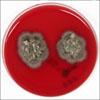Abstract
Scedosporium apiospermum, the anamorph of Pseudallescheria boydii, is a ubiquitous saprophytic fungus. S. apiospermum can cause life-threatening infections usually in immunocompromised patients or after near-drowning incidents. Here, we report the first case of disseminated infection caused by S. apiospermum after near-drowning in Korea. A 44-year-old healthy man developed aspiration pneumonia, followed by multiple brain abscesses, and endopthalmitis, after a near-drowning incident in a septic tank. S. apiospermum infection was diagnosed on the 33rd day after the incident had occurred. The patient died from the progressive renal failure 255 days after incident, although he had been treated with voriconazole.
Figures and Tables
Figure 1
Chest PA showed (A) pneumonic consolidation at both lower lung fields and chest CT showed (B) parenchymal infiltrates through both lung fields on the admission. Chest PA showed (C) patch consolidation infiltration at both lung fields on 4 days after the admission.

Figure 2
Brain CT (A) obtained 33 days after the near-drowning accident and axial T2 weighted MR image (B) showed multiple hyperintense lesions with slightly hypointense rim with minimal surrounding edema.

References
1. Cortez KJ, Roilides E, Quiroz-Telles F, Meletiadis J, Antachopoulos C, Knudsen T, et al. Infections caused by Scedosporium spp. Clin Microbiol Rev. 2008. 21:157–197.
2. Kaltseis J, Rainer J, De Hoog GS. Ecology of Pseudallescheria and Scedosporium species in human-dominated and natural environments and their distribution in clinical samples. Med Mycol. 2009. 47:398–405.
3. Buzina W, Feierl G, Haas D, Reinthaler FF, Holl A, Kleinert R, et al. Lethal brain abscess due to the fungus Scedosporium apiospermum (teleomorph Pseudallescheria boydii) after a near-drowning incident: case report and review of the literature. Med Mycol. 2006. 44:473–477.
4. Katragkou A, Dotis J, Kotsiou M, Tamiolaki M, Roilides E. Scedosporium apiospermum infection after near-drowning. Mycoses. 2007. 50:412–421.
5. Kowacs PA, Soares Silvado CE, Monteiro de Almeida S, Ramos M, Abrão K, Madaloso LE, et al. Infection of the CNS by Scedosporium apiospermum after near drowning. Report of a fatal case and analysis of its confounding factors. J Clin Pathol. 2004. 57:205–207.
6. van der Vliet JA, Tidow G, Kootstra G, van Saene HF, Krom RA, Sloof MJ, et al. Transplantation of contaminated organs. Br J Surg. 1980. 67:596–598.
7. Haukohl RS, Sadoff HB. Mycetoma: report of a case due to Monosporium apiospermum in a native of Minnesota. Wis Med J. 1954. 53:477–479.
8. Chung JW, Park SJ, Sung H, Kim MN, Kim BS, Lee SG. A case of disseminated infection due to Scedosporium apiospermum in a liver-transplantation recipient. Korean J Lab Med. 2005. 25:421–424.
9. Nucci M. Emerging moulds: Fusarium, Scedosporium and Zygomycetes in transplant recipients. Curr Opin Infect Dis. 2003. 16:607–612.
10. Troke P, Aguirrebengoa K, Arteaga C, Ellis D, Heath CH, Lutsar I, et al. Treatment of scedosporiosis with voriconazole: clinical experience with 107 patients. Antimicrob Agents Chemother. 2008. 52:1743–1750.
11. Hariprasad SM, Mieler WF, Holz ER, Gao H, Kim JE, Chi J, et al. Determination of vitreous, aqueous, and plasma concentration of orally administered voriconazole in humans. Arch Ophthalmol. 2004. 122:42–47.
12. Jain A, Egbert P, McCulley TJ, Blumenkranz MS, Moshfeghi DM. Endogenous Scedosporium apiospermum endophthalmitis. Arch Ophthalmol. 2007. 125:1286–1289.
13. Yoo D, Lee WH, Kwon-Chung KJ. Brain abscesses due to Pseudallescheria boydii associated with primary non-Hodgkin's lymphoma of the central nervous system: a case report and literature review. Rev Infect Dis. 1985. 7:272–277.




 PDF
PDF ePub
ePub Citation
Citation Print
Print




 XML Download
XML Download